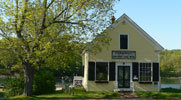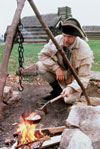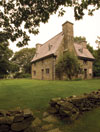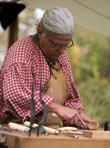Every day that George Washington walked out to his troops, he know full well he had little hope of supplies coming for his men during the grueling winter at Valley Forge. Today, visitors can walk the same path as the famous general and other influential figures and early settlers at some of the many Colonial attractions in the Northeast.
Historic museums, houses and parks tell stories of the founding of our country, including some not widely known ones, such as facts about the Constitution of Vermont or the heritage of the Quakers.
Valley Forge National Historic Park
Valley Forge, Pa.
With a death toll of about 2,000 soldiers, Washington’s winter spent at Valley Forge incurred more American fatalities than the battles of Brandywine and Germantown combined without so much as a skirmish. The 3,600-acre Valley Forge National Historic Park recounts the winter of disease, hunger and cold that American forces braved while fighting for the country’s freedom.
 |
| Guests can compare the life in a Colonial town at Museums of Old York’s general store, above, versus life in a military camp at Valley Forge National Historic Park, right. Museums of Old York |

Step-on guides for a driving tour of the park narrate stories of the larger-than-life characters that survived the 1777-1778 encampment of the Continental Army. An 18-minute film and exhibits at the welcome center introduce visitors to how significant the months spent there were to the country.
“It is the birthplace of the United States Army,” said Anne Marie Maher, director, cooperative sales, and marketing manager for the park. “It was a turning point in the war where Washington was able to rally the troops, gain some political support and hire Baron Friedrich von Steuben to train the troops.”
Guests can receive a guided tour of Washington’s headquarters inside the Isaac Potts House and of the Muhlenberg Brigade where, in re-created soldier huts, the daily routines of the soldiers are portrayed. This fall, a 1920s train station will open next to Washington’s headquarters with displays chronicling the general’s career.
At the Washington Memorial Chapel, a 1917 Gothic-revival Episcopal church allows visitors to reflect on Washington with glass windows depicting scenes from his life.
Great Friends Meeting House
Newport, R.I.
When kill-or-be-killed tactics were the order of the day, preaching pacifism to land-hungry colonists wasn’t a popular notion. Early Quakers of America found themselves persecuted even though they had left Europe, so many of the 17th-century Quakers decided to live in religiously tolerant Newport.
The 1699 Great Friends Meeting House teaches guests about the plain and peaceful religious sect that once built the worship building to encourage discussions on theology, peaceful alternatives to war and the abolition of slavery.
“Newport’s religious diversity was one of the defining factors that set it apart in the Colonial period,” said Ruth Taylor, executive director of the Newport Historical Society. “The Quaker’s style and collaborative nature helped them not only in their prosperous businesses, but also to discuss the important issues of the day.”
Tours of the Meeting House relate the history of the simple building and the mentality of the congregation that filled it until 1905. The oldest house of worship in Rhode Island, the structure still retains its 1807 appearance with a medieval-looking interior and a bell tower.
www.newporthistorical.org/sites.htm
Old Constitution House
Windsor, Vt.
Though the Declaration of Independence seemed radical to some in its call for equality, the Vermont Constitution became the first American constitution to prohibit slavery, allow men without property to vote and authorize a public school system.
Less than a year after Thomas Jefferson signed his declaration, Vermont delegates in a Windsor tavern signed their own groundbreaking constitution in 1777 to declare the independent Republic of Vermont.
 |
| At the Old Constitution House, visitors learn about Vermont’s stint as sovereign nation. Vermont Agency of Commerce and Community Development |
Now dubbed the Old Constitution House, the birthplace of Vermont still retains much of its Colonial style, along with exhibits on the drafting and influence of the constitution.
“It is important to talk about the role Vermont played in the early years of America and how it was considered its own country for 14 years,” said William Jenney, regional site administrator for the Vermont Division for Historic Preservation. “Since it was such a highly contested area with the British and early Americans, it became important to create Vermont’s Constitution right there and then.”
The Union welcomed Vermont as its 14th state in 1791. Period rooms reflect the Old Constitution House’s use as an early tavern; exhibits include artifacts from the historic signing, such as the delegate’s table, a copy of the constitution and a sermon from the Windsor convention.
www.historicvermont.org/constitution
Henry Whitfield State Museum
Guilford, Conn.
Although the idea of colonists fortifying their homes with wooden fences against Native American attack remains a common image, a Puritan settlement created 19 years after the Pilgrims landed at Plymouth paints a different picture. In 1639, minister Henry Whitfield began constructing four large stone houses for the town’s defense system that looked straight out of medieval England.
 |
| Henry Whitfield State Museum has a stone fortress build 19 years after the Plymoth colony. Connecticut Commission on Culture and Tourism |
The Henry Whitfield State Museum preserves the remaining stone house as a glimpse into a colony more afraid of the French and the Spanish than of a Native American attack. The colonists had peacefully bought their land from the natives when they arrived.
“People are used to seeing wood-frame Colonial houses, so the fact this colony built a stone fortress is unusual,” said Karin Peterson, museum director. “The hall is very medieval with huge massive walls and a fireplace so big you could have a party inside. Most of the heat went up the chimney while snow and rain would come down, but that’s how they built chimneys back then.”
Whitfield used his private home for religious services and a meeting space for the religiously persecuted community. Now the oldest stone home in New England, the museum shelters three floors of 17th- through 19th-century furnishings and artifacts. Exhibits about the distinctive religious settlement hang in the museum’s visitors center.
National Heritage Museum
Lexington, Mass.
When Paul Revere galloped through Lexington on his midnight ride to warn colonists that the British were coming, he rode past the doorstep of the current National Heritage Museum. Today, the museum focuses on the country’s formation with exhibits on American Revolutionary giants like Revere, Washington and Benjamin Franklin.
Changing exhibits about America’s continued development also filter in and out, with subjects as diverse as Route 66 and the evolution of toys.
The museum carries an extensive collection of items used by the American Freemasons, who played a pivotal role in the founding of the United States. The enigmatic Freemasons were sensationalized in the movie National Treasure, and artifacts such as Masonic jewels, a sword and an altar have helped the museum decode the group’s symbols and peer into its secret rituals.
Other highlights of the museum include a rare 15-star American flag, Colonial artwork and an exhibit on how the Lexington farmers had to transform into “citizen soldiers” for the
 |
| Reenactments of both historic moments and everyday life occur at Colonial sites, such as toolmaking demonstrations at the Old Constitution House. Vermont Agency of Commerce and Community Development |
American Revolution.
Museums of Old York
York, Maine
A seemingly innocuous red building in Maine that once housed a mixture of thieves, murderers and drunkards is now the Museums of Old York’s Old Gaol. The 1719 structure imprisoned all types of criminals from Maine until 1820.
In the Colonial jail re-enactment “Gaol Break,” actors portray period jailers and prisoners for a look at the criminal justice system of the New World.
Other aspects of the 1641 Old York colony also are presented in historic interpretations at the site’s nine historic museum buildings. Living-history programs give groups the opportunity to chat with characters from one of New England’s earliest Colonial settlements and maybe learn a trade, such as hearth cooking or wool spinning.
The museum’s treasured antiques include the Bulman Bedhangings, which are the only complete set of 18th-century American crewelwork bed curtains known to exist. While admiring these items, guests can appear to time travel through various historic 18th-century structures, including a tavern, a schoolhouse, a wharf and a Georgian home.
“People visiting the Museums of Old York can learn how connected a little place in Maine was to the whole globe,” said Scott Stevens, executive director of the museum. “We have pieces from Europe and the West Indies. There was a global economy even in the 1700s. It’s an antique-lover’s paradise.”










